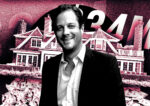Moshe Piller, who ranked 28th on this year’s “worst landlord watchlist,” just got hit with a city lawsuit over 1,900 violations across 927 apartments, an average of two per unit.
Mayor Eric Adams said the filing is a part of his “ramped-up” enforcement against owners whose buildings’ violations place tenants at risk. Adams said the suit should serve as a “clear message” that landlords “who break the law will pay.”
“While Piller made millions in profits, his tenants paid the price,” Adams said in a statement. “The time of landlords openly flouting the law and harassing tenants is over.”
The mayor did divulge the source of his information about Piller’s profits.
The complaint, filed in state court Thursday, alleges that Piller failed for years to remediate housing, fire code and health violations across his portfolio as his buildings fell into disrepair.
“The defendants have allowed their buildings to deteriorate to the point where they pose an imminent threat to the health and safety of the tenants and the public,” the suit reads. Piller did not respond to a request for comment.
Read more


The majority of the 15 buildings named in the suit are in the Bronx and Upper Manhattan. Three are in Brooklyn, south and west of Prospect Park.
Piller’s violations run the gamut.
At one building in the Soundview neighborhood of the Bronx, at 1742 East 172nd Street, the city flagged the owner for creating illegal units in the laundry room and cellar with inadequate fire exits.
The building’s elevators are either inoperable or riddled with safety issues, including defective brakes and damaged cables, the complaint reads. And the property also has five open lead-paint violations and 22 for mice and roaches, plus a handful of health code violations for failure to eliminate those infestations.
Piller failed to make four doors in the building self-closing in compliance with city law. A faulty self-closing door allowed January’s deadly fire in the Bronx to spread throughout the building.
The suit also alleges that when applying for work permits, Piller failed to certify that his buildings contained rent-regulated tenants. All but six of the 927 units identified in the complaint are rent-stabilized. The complaint says omitting the units’ stabilization status obliges Piller to prove he did not intend to harass tenants.
Owners of rent-stabilized buildings claim they have struggled to keep up with repairs since the 2019 rent law curtailed the rent hikes landlords could make to cover building improvements and unit upgrades. Because so little of the cost can be passed on to tenants, landlords say they have had to forgo some needed renovations.
A report by the Rent Guidelines Board last week showed the number of distressed stabilized properties — ones in which maintenance costs exceeded gross income — has risen every year since 2016. The report found 6.5 percent of the city’s stabilized housing stock was distressed in 2020, a full percentage point more than the year before.
But Piller’s problems did not begin with the 2019 rent law. Three years before it, 12 tenants at 2010 Newkirk Avenue in Ditmas Park sued him for rent overcharges nearing $90,000. The renters also claimed Piller had unleashed a “campaign of harassment” to force them out of their rent-regulated units.
In 2018, a state judge ordered Piller to pay back the overcharges, plus damages.




